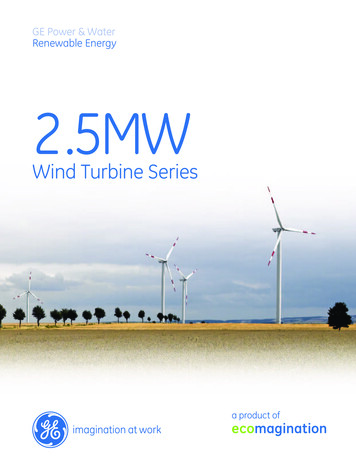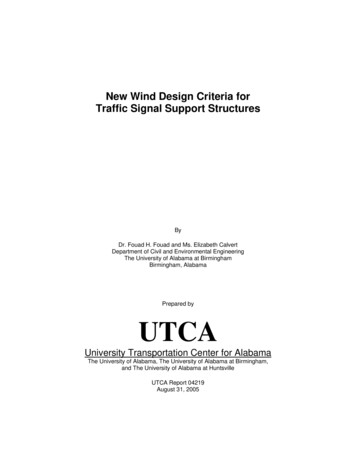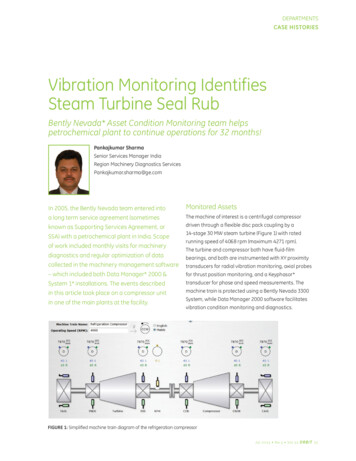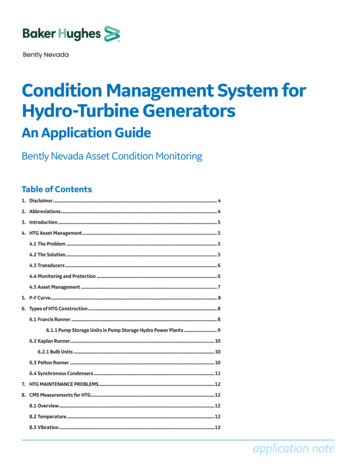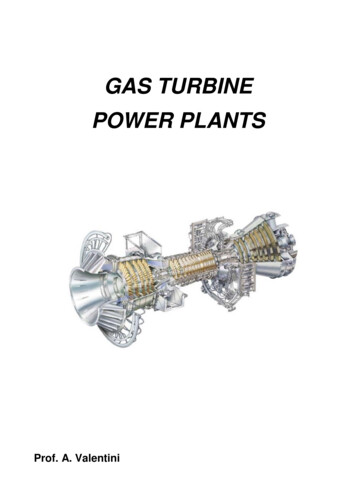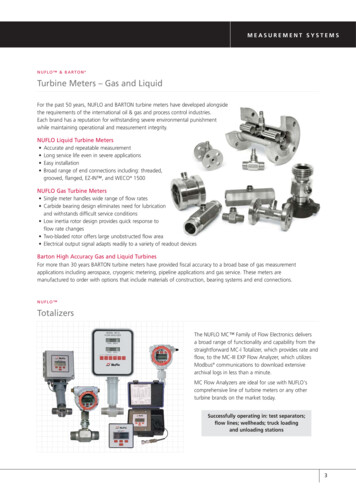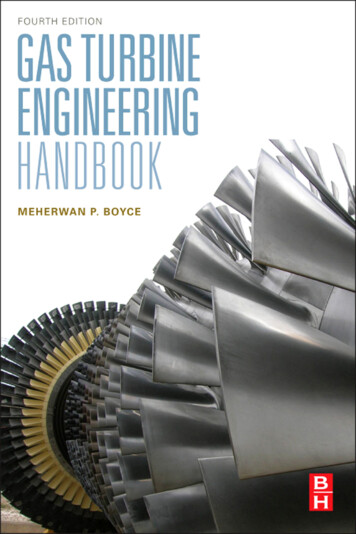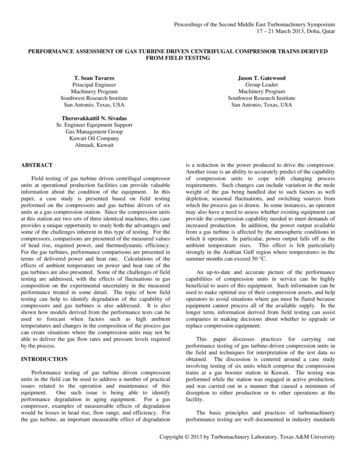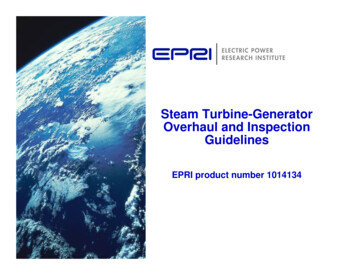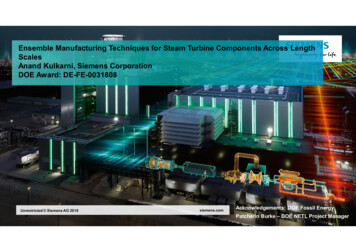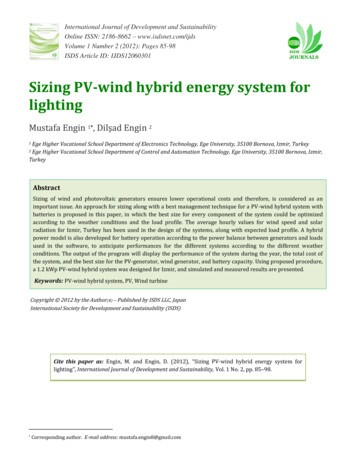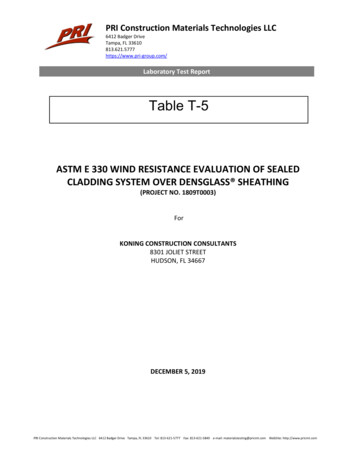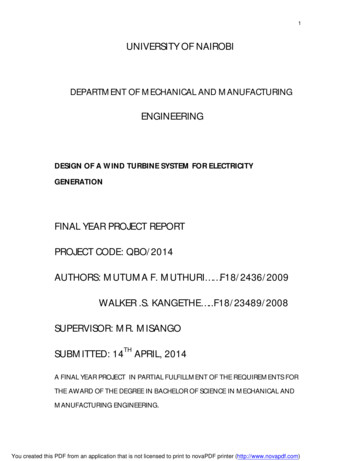
Transcription
1UNIVERSITY OF NAIROBIDEPARTMENT OF MECHANICAL AND MANUFACTURINGENGINEERINGDESIGN OF A WIND TURBINE SYSTEM FOR ELECTRICITYGENERATIONFINAL YEAR PROJECT REPORTPROJECT CODE: QBO/2014AUTHORS: MUTUMA F. MUTHURI F18/2436/2009WALKER .S. KANGETHE .F18/23489/2008SUPERVISOR: MR. MISANGOSUBMITTED: 14TH APRIL, 2014A FINAL YEAR PROJECT IN PARTIAL FULFILLMENT OF THE REQUIREMENTS FORTHE AWARD OF THE DEGREE IN BACHELOR OF SCIENCE IN MECHANICAL ANDMANUFACTURING ENGINEERING.You created this PDF from an application that is not licensed to print to novaPDF printer (http://www.novapdf.com)
2DECLARATIONWe declare that this is our original work and has not been published or presented for a degreeaward in any other university/college/institution there before.STUDENTSNAMESIGNATUREDATEMUTUMA MUTHURI.SIMON KANG ETHE.SUPERVISORThis report has been submitted by the above students for examination with your approval asuniversity lecturer and supervisor of the projectSIGNATURE.DATE.You created this PDF from an application that is not licensed to print to novaPDF printer (http://www.novapdf.com)
3DEDICATIONThis project is dedicated to our beloved parents for their continuous support in bringing usthis far academically and morally to the University of Nairobi, Our supervisor Mr. Misangowho guided us through and to the Mechanical and manufacturing Engineering Department.You created this PDF from an application that is not licensed to print to novaPDF printer (http://www.novapdf.com)
4ACKNOWLEDGEMENTWe thank the Lord God Almighty for giving u strength and sustaining us during the course ofthis projectSpecial thanks go to our able project supervisor Mr. QBO Misango for being supportivethroughout the course of this project, without which the progress of our work would bejeopardizedWe also acknowledge the Kenya Meteorological Department and Ngong wing generationproject for its support in giving us information regarding wind data pattern in Kenya. We alsothank the ministry of energy, Kenya Generating Company KenGen) and Kenya Power for thedata provided unto us in the course of undertaking our project.Finally we wish to thank the Department of Mechanical and Manufacturing Engineering forthe support in funding this project and also offering guidance.You created this PDF from an application that is not licensed to print to novaPDF printer (http://www.novapdf.com)
5LIST OF FIGURESPAGENUMBERFigure 1.0: Components of a conventional wind turbine.4Figure 1.1: Detailed view of a wind turbine.5Figure 1.2: Vertical and Horizontal wind turbines.8Figure 2.1: Actuator disc.18Figure 2.2: Stream boundary at rotor plane.22Figure 2.3: Sketch of wake.23Figure 2.4: An airfoil.26Figure 2.5: An aerofoil.27Figure 2.6: Aerofoil shape of a bladder.28Figure 2.7: Sketch of a 3-blade wind turbine.29Figure 3.0: Diagram of forces acting on aerofoil.38Figure 3.1: Pattern of wind distribution in Kenya.39Figure 3.2: Diurnal wind speed over Marsabit .39Figure 3.3: Diurnal variation of the wind power variation over Marsabit.40Figure 3.4: Graph of wind speed against Days of Year.40Figure 3.5: Graph of power against Days of the Year.41Figure 3.6: Major parts of a permanent magnet generator.42Figure 3.7: A 6KW permanent magnet generator.43Figure 3.8: Dimensions of generator.43Figure 4.0: Types of blades.48Figure 4.1: Variation of stress verses Time.49You created this PDF from an application that is not licensed to print to novaPDF printer (http://www.novapdf.com)
6LIST OF FIGURESPAGE NUMBERFigure 4.2: Blade manufacturing industry (http://www.google.com/3905714943.html).84Figure 5.0: A graph of coefficient of performance verses Tip speed Ratiofor17% thick LS (1) 4/7 aerofoil (http://www.google.com/876678669.html).60Figure 5.1: A graph of coefficient of lift, coefficient of drag verses Angle of attackfor17% thick LS (1) 4/7 aerofoil (http://www.google.com/876678668.html).61Figure 5.2: A cross section view of an aerofoil.84Figure 5.3: A hand drawn cross section view of an aerofoil .84Figure 5.4: variation of bending moment with radius.85Figure 5.5: A sketch of blade elements arrangement.88Figure 5.6: A sketch of inner and outer diameters.94Figure 5.7: parts of the 6KW wind turbine.102Figure 5.8: Front view of the 6KW wind turbine.103Figure 5.9: 3-blade rotor of the 6KW wind turbine.104LIST OF TABLESPAGE NUMBERTable 1.0: Terrain verses Z0 (mm) whereZ0is the relative surface roughness.16Table 2.0: Tip speed ration verses number of blades.35Table 3.0: Tip speed ration verses number of blades.59Table 4.0: Blade elements chord length, twist distribution and pitch (summary).71Table 5.0: Material selection index.79Table 6.0: Summary of material selection coefficient.81Table 7.0: Blade elements chord length and thickness.92Table 8.0: Blade element and corresponding bending moment.93Table 9.0: Blade elements characteristics.97You created this PDF from an application that is not licensed to print to novaPDF printer (http://www.novapdf.com)
7TABLE OF CONTENTSPAGE ivCHAPTER ONE: GENERATION OF ELECTRICAL POWER USING WINDENERGY1.0.0 Objective.21.0.1 Introduction.21.0.2 Literature review.31.0.3 Components of nacelle.41.0.4 Low speed and high speed shaft.51.0.5 The gearbox.61.0.6 Coupling.61.0.7 Bearings.61.0.8 Mechanical brakes.61.0.9 The generator.61.1.0 Power electronics.61.1.1 Cooling unit.71.1.2 Yaw mechanism and four points bearing.71.1.3 Electronic controllers.71.1.4 Sensors.81.1.5 Types of turbines.81.1.6 Orientation of axis.81.1.7 Wind turbine classifications.91.1.8 Power in wind.10CHAPTER TWO: DESIGN OF WIND TURBINE SYSTEM AND THEORY2.0.0 Theory.112.0.1 Statistical methods of determining wind distribution.12You created this PDF from an application that is not licensed to print to novaPDF printer (http://www.novapdf.com)
82.0.2 Wind variation with height.142.0.3 Logarithmic profile.142.0.4 Values of surface roughness length for various types of terrain.162.0.5 Effects of terrain.172.0.6 Depression.172.0.7 One dimensional momentum theory and Betz limit.182.0.8 The actuator disc.182.0.9 Ideal horizontal axis wind turbine with ware rotation.212.1.0 Airfoils and general concepts of aerodynamics.262.1.1 General rotor blade performance prediction.262.1.2 Blade element theory.292.1.3 Blade element momentum theory.302.1.4 Calculation of power coefficient.312.1.5 Tip loss: effect on power coefficient of number of blades.322.1.6 Blade shape for optimum rotor with wake.33CHAPTER 3: ROTOR DESIGN PROCEDURE3.0.0 General rotor design procedure.353.1.1 Wind density and distribution in Kenya.383.1.2 Case study: Marsabit region.413.1.3 Generator specifications.413.1.4 Permanent magnet generators.423.1.5 Generator weight.433.1.6 Generator dimensions.433.1.7 Generator number of poles.443.1.8 Power output.443.1.9 Power storage.443.2.0 Height of the tower.44You created this PDF from an application that is not licensed to print to novaPDF printer (http://www.novapdf.com)
93.2.1 Tower construction.453.2.2 The foundation of the tower.453.2.3 Power storage system.45CHAPTER FOUR: MECHANICS AND DYNAMICS OF WIND TURBINE4.0.0 Mechanics and dynamics of wind turbine.464.0.1 Wind turbine loads 464.0.2 Steady loads .464.0.3 Cyclic loads .464.0.4 Transient loads .474.0.5 Stochastic loads .474.0.6 Resonance induced load
Figure 3.4: Graph of wind speed against Days of Year.40 Figure 3.5: Graph of power against Days of the Year.41 Figure 3.6: Major parts of a permanent magnet generator.42 Figure 3.7: A 6KW permanent magnet generator.43 Figure 3.8: Dimensions of generator.43 Figure 4.0: Types of blades.48 Figure 4.1: Variation of stress verses Time.49 You created this PDF from an .
